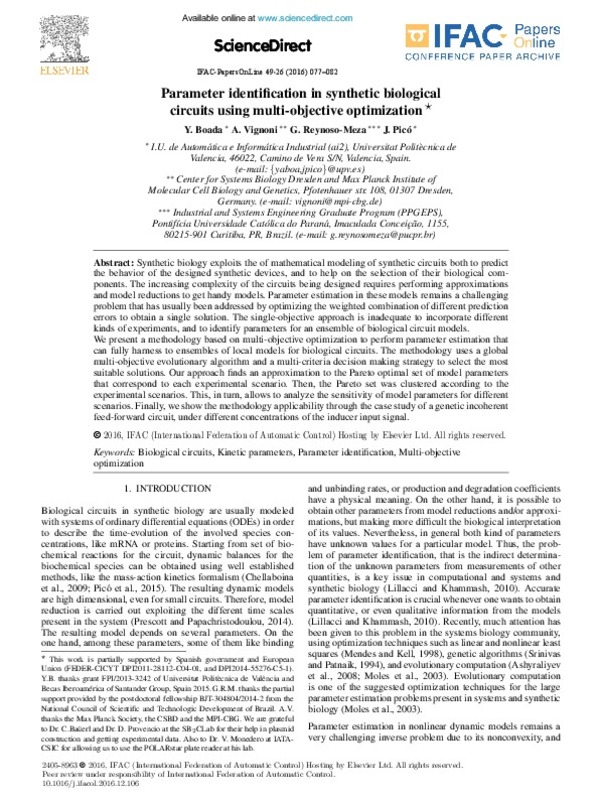Boada-Acosta, YF.; Vignoni, A.; Reynoso Meza, G.; Picó, J. (2016). Parameter Identification in Synthetic Biological Circuits Using Multi-Objective Optimization. IFAC-PapersOnLine. 49(26):77-82. https://doi.org/10.1016/j.ifacol.2016.12.106
Por favor, use este identificador para citar o enlazar este ítem: http://hdl.handle.net/10251/150443
|
Título:
|
Parameter Identification in Synthetic Biological Circuits Using Multi-Objective Optimization
|
|
Autor:
|

 Boada-Acosta, Yadira Fernanda
Boada-Acosta, Yadira Fernanda

 Vignoni, Alejandro
Reynoso Meza, Gilberto
Vignoni, Alejandro
Reynoso Meza, Gilberto

 Picó, Jesús
Picó, Jesús
|
|
Entidad UPV:
|
Universitat Politècnica de València. Departamento de Ingeniería de Sistemas y Automática - Departament d'Enginyeria de Sistemes i Automàtica
|
|
Fecha difusión:
|
|
|
Resumen:
|
[EN] Synthetic biology exploits the of mathematical modeling of synthetic circuits both to predict the behavior of the designed synthetic devices, and to help on the selection of their biological coin portents. The increasing ...[+]
[EN] Synthetic biology exploits the of mathematical modeling of synthetic circuits both to predict the behavior of the designed synthetic devices, and to help on the selection of their biological coin portents. The increasing complexity of the circuits being designed requires performing approximations and model reductions to get handy models. Parameter estimation in these models remains a challenging problem that has usually been addressed by optimizing the weighted combination of different prediction errors to obtain a single solution. The single-objective approach is inadequate to incorporate different kinds of experiments, and to identify parameters for an ensemble of biological circuit models. We present a methodology based on multi-objective optimization to perform parameter estimation that can fully harness to ensembles of local models for biological circuits. The methodology uses a global multi-objective evolutionary algorithm and a multi-criteria decision making strategy to select the most suitable solutions. Our approach finds an approximation to the Pareto optimal set of model parameters that correspond to each experimental scenario. Then, the Pareto set was clustered according to the experimental scenarios. This, in turn, allows to analyze the sensitivity of model parameters for different scenarios. Finally, we show the methodology applicability through the case study of a genetic incoherent feed-forward circuit, under different concentrations of the inducer input signal. (C) 2016 IFAC (International Federation Of Automatic Control) Hosting by Elsevier Ltd. All rights reserved.
[-]
|
|
Palabras clave:
|
Biological circuits
,
Kinetic parameters
,
Parameter identification
,
Multi-objective
,
Optimization
|
|
Derechos de uso:
|
Reserva de todos los derechos
|
|
Fuente:
|
IFAC-PapersOnLine. (eissn:
2405-8963
)
|
|
DOI:
|
10.1016/j.ifacol.2016.12.106
|
|
Editorial:
|
Elsevier
|
|
Versión del editor:
|
https://doi.org/10.1016/j.ifacol.2016.12.106
|
|
Título del congreso:
|
6th IFAC Conference on Foundations of Systems Biology in Engineering (FOSBE 2016)
|
|
Lugar del congreso:
|
Magdeburg, Germany
|
|
Fecha congreso:
|
Octubre 09-12,2016
|
|
Código del Proyecto:
|
info:eu-repo/grantAgreement/CNPq//BJT%2F304804%2F2014-2/
info:eu-repo/grantAgreement/MINECO//DPI2014-55276-C5-1-R/ES/BIOLOGIA SINTETICA PARA LA MEJORA EN BIOPRODUCCION: DISEÑO, OPTIMIZACION, MONITORIZACION Y CONTROL/
info:eu-repo/grantAgreement/UPV//FPI%2F2013-3242/
info:eu-repo/grantAgreement/MINECO//UPOV13-3E-1889/ES/Unidad de implementación y caracterización de circuitos biológicos sintéticos/
info:eu-repo/grantAgreement/MICINN//DPI2011-28112-C04-01/ES/MONITORIZACION, INFERENCIA, OPTIMIZACION Y CONTROL MULTI-ESCALA: DE CELULAS A BIORREACTORES/
|
|
Agradecimientos:
|
This work is partially supported by Spanish government and European Union (FEDER-CICYT DPI2011-28112-C04-01, and DPI2014-55276-C5-1). Y.B. thanks grant FP/2013-3242 of Universitat Politecnica de Valencia and Becas Iberoamerica ...[+]
This work is partially supported by Spanish government and European Union (FEDER-CICYT DPI2011-28112-C04-01, and DPI2014-55276-C5-1). Y.B. thanks grant FP/2013-3242 of Universitat Politecnica de Valencia and Becas Iberoamerica of Santander Group, Spain 2015. G.R.M. thanks the partial support provided by the postdoctoral fellowship BJT-304804/2014-2 from the National Council of Scientific and Technologic Development of Brazil. A.V. thanks the Max Planck Society, the CSBD and the MPI-CBG. We are grateful to Dr. C,Bauerl and Dr, D. Provencio at the SB2CLab for their help in plasmid construction and getting experimental data. Also to Dr. V. Monedero at IATACSIC for allowing us to use the POLARstar plate reader at his lab,
[-]
|
|
Tipo:
|
Artículo
Comunicación en congreso
|









